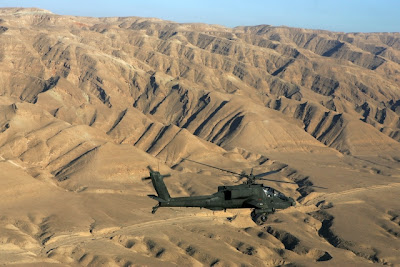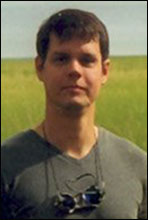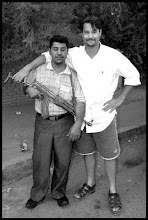Kirk von Ackermann's car was discovered abandoned on October 9, 2003 in the Jabal Hamrin mountains. The approximate location was given as Latitude North 34 Degrees 54’ 16.998” Longitude East 43 Degrees 57’ 45.836” (34 54.169 - 43 57.458) at an altitude of 232 meters.
Driving, it's about 25 miles outside of Tikrit.
View Larger Map
There are a few video clips of the area online, both shot from helicopters.
Crossing Ridgeline In Iraq by galtcitycouncil
Video from my tour in Iraq in 2005. This shows us crossing a mountain ridgeline heading for Kirkuk from Tikrit. Notice that Iraq is very green during the spring. Also, most people forget Iraq has many mountains in the north.
I really wish there was just a little bit more to this next clip as it ends just as the hills begin to rise.
Chopper Ride departing FOB Danger - Tikrit by Eric
Just a quick clip of an airlift from FOB Danger in Tikrit en route to FOB Warrior in Kirkuk.
There are numerous news reports of check points, patrols and convoys along the road between Tikrit and Kirkuk. The first gives an idea of how long it takes a convoy to move through the area.
Soldiers Keep Their Eyes on the Road During Combat Logistics Patrols in Iraq
By Charlie Coon, Stars and Stripes, Mideast Edition March 7, 2005
Tuesday's convoy was typical, it ran from Tikrit to Kirkuk and back, about 65 miles and 2 hours, 45 minutes each way.The area has had its own share of power struggles both political and criminal.
The route snaked through downtown Tikrit, Saddam Hussein's hometown, and moved out onto a crusty two-lane road dubbed IED Alley for its history of roadside bombs that have been placed there. [...]
The convoy leaves Tikrit and enters a barren land of dirt and rocks, hills and crevices and the occasional sheep farmer.
Tensions boil over between Kurds and Arabs
By Patrick Cockburn, Independent, April 14, 2003
At least eight people were killed in gun battles between Iraqi Kurds and Arab tribes south of Kirkuk yesterday as Arabs in northern Iraq become increasingly nervous of the Kurdish advance south.In The North, Fear And Hate
The fighting was around the town of Hawi Jah on the road between the Iraqi oil centre of Kirkuk and the city of Tikrit.
"It has been chaos. The Kurds are here to steal, and have killed some of our people while trying to rob them on the road," said one leader of the al-Obaid tribe. Arabs said five people were killed in the clashes while the peshmerga said three of their number were killed.
By Borzou Daraghi, Columbia Journalism Review, May-June 2003
Muhammad and Tahseen had helped me explore the back roads and smugglers' routes in the no-man's-land surrounding government-controlled Kirkuk. Antiaircraft tracers lit up my driver's face as he watched the coalition's nighttime bombing raids over that city, his hometown, and the Kurds' lost dream city. On April 10, we gunned it in a convoy behind Kurdish pesh merga and United States Special Forces as they stormed Khaneqin, a Baghdad-controlled city to the south of the autonomous Kurdish area, soaking up the adulation of residents welcoming us to their newly liberated town. We sped through the desert past miles of abandoned Iraqi military positions and deserting Iraqi soldiers on our way to Kirkuk.
But those were all in Kurdistan. Now we were in Arabia, and my driver and translator were like fish out of water. All day long on the drive to Tikrit they had complained and fretted and resisted. They weren't unique. Two journalists from NBC had to fire one of their drivers midway to Tikrit because he refused to go any further.
But leaving Kevin behind was an altogether different story. "Stop the car, you coward!" I yelled at Muhammad. "Go back now! I'm not going to leave Kevin behind."
As if waking up from a trance, he finally began to slow down. We turned around and went back to get the photographer. We found him putt-putting along at five miles an hour in his ailing car. He was very glad to see us.
Kevin's Kurdish driver, Adnan, had raced his engine and clogged up the carburetor of his Nissan. Kevin said a nice Arab taxi driver had offered to help, but Adnan contemptuously shooed him away. He said he didn't believe any Arab could fix his car.
More...





